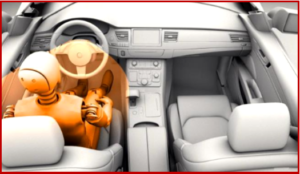The National Highway Traffic Safety Administration, aka NHTSA, along with the state of Virginia have announced $5.1 million in funding to develop and deploy DADSS – Driver Alcohol Detection System for Safety.This technology could eliminate drunk driving, which is responsible for more than 10,000 deaths annually in the US.
DADSS is a public-private partnership between the government and automakers to develop safety technology to help passively detect a driver’s blood alcohol concentration (BAC) and prevent drivers from starting a vehicle if they are at or above the .08 legal BAC limit in all 50 states.
The goal of the DADSS research program is to advance the state of passive alcohol detection technology by developing a system that is fast, accurate, reliable and affordable – all without affecting normal driving behavior. The program is exploring two different technologies for vehicle integration: a breath-based system and a touch-based system.
Breath-Based System
This measures the alcohol level in a driver’s exhaled breath unobtrusively. It will be designed to take instantaneous readings as the driver breathes normally and to accurately and reliably distinguish between the driver’s breath and that of any passengers. A breath-based system being developed by Autoliv Development means in theory that Drivers will be able to enter the vehicle and breathe as they normally would.
The Autoliv system draws the driver’s exhaled breath into a sensor, which measures the concentrations of alcohol and carbon dioxide present. The known quantity of carbon dioxide in human breath serves as an indicator of the degree of dilution of the alcohol concentration in exhaled air.
Molecules of alcohol and those of tracers such as carbon dioxide absorb infrared radiation at specific wavelengths. The Autoliv device directs infrared light beams on the breath sample and analyzes the wavelengths returned to calculate the alcohol concentration. Autoliv continues to move towards a prototype that can be integrated into a vehicle by utilizing mirrors to reduce the required optical length of the device. The device is claimed to be highly sensitive and able to analyze diluted breath samples at dilutions expected from a driver’s natural breath plume.
Touch-Based System
This technology measures blood alcohol levels under the skin’s surface by shining an infrared-light through the fingertip. It will be integrated into current vehicle controls, such as the start button or steering wheel, and take multiple readings in less than a second.
The potential problem with this moving forward is the fate of bankrupt Takata. It is based on the so-called Takata-TruTouch technology that uses spectroscopy to measure alcohol in the driver’s tissue. This technology broadens the options for an integrated system that – in theory – can reliably prevent drunk driving while remaining invisible to any driver under the legal limit.
“Drunk driving crashes are no accident – they are 100 % preventable. They all connect back to human choices and errors, but we’re not stopping there,” said NHTSA Administrator Dr. Mark Rosekind. “With the help of our safety partners we’re looking at a technological path forward to create a world where there is no more drunk driving.”
Sobering Facts on Drunk Driving
- It is against the law in all 50 States, the District of Columbia, and Puerto Rico for adults over the age of 21 to drive a vehicle if you have a blood alcohol concentration (BAC) of .08 or higher.
- In 2015, 10,265 people died in drunk driving crashes. The drivers involved in 67 percent of those crashes had a BAC of .15 or higher (nearly twice the legal limit of .08).
- During the 2015 Christmas holiday period (6 p.m. December 24th – 5:59 a.m. December 28th), the nation lost 34 lives per day in drunk driving crashes—a total of 120 deaths over 3.5 days.
- During the New Year’s holiday period (6 p.m. December 31, 2014 – 5:59 a.m. January 5, 2015) the nation lost 31 lives per day in drunk driving crashes—a total of 139 deaths over 4.5 days.
- These two holidays combined accounted for 259 lives lost in drunk driving crashes.


